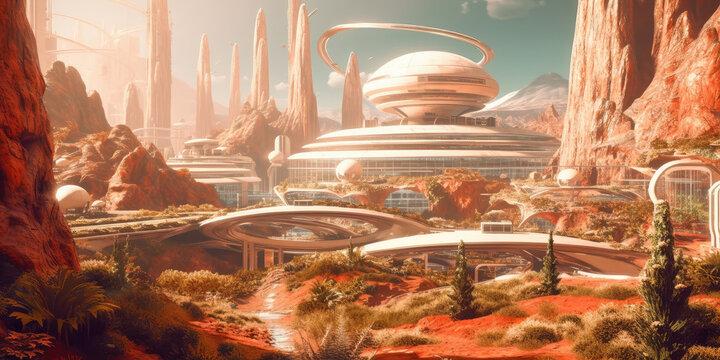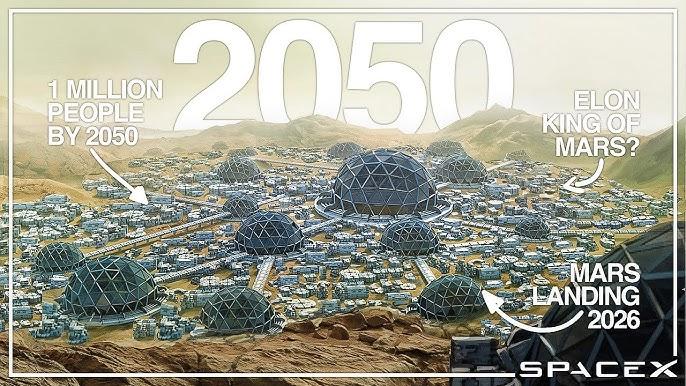
Elon Musk, the visionary entrepreneur behind SpaceX, has long captivated the world with his audacious goals for humanity’s future. His latest ambition, announced through various platforms including interviews and posts on X, pushes the boundaries of imagination even further: a city on Mars housing one billion people by 2050, equipped with amenities surpassing those found on Earth. This bold vision, rooted in Musk’s desire to make humanity a multi-planetary species, represents a monumental leap in space exploration and colonization. While the timeline and scale of this plan have sparked skepticism, recent advancements by SpaceX and Musk’s unwavering commitment suggest that this futuristic Martian metropolis may be closer to reality than many believe.
Musk’s dream of a Martian city stems from his belief that humanity’s survival depends on becoming a multi-planetary civilization. He has frequently cited existential threats to Earth, such as asteroid impacts, supervolcanoes, or the eventual expansion of the Sun, which could render the planet uninhabitable in the distant future. By establishing a self-sustaining colony on Mars, Musk aims to create a backup for human civilization, ensuring its continuity even if catastrophe strikes Earth. The proposed city, envisioned as a network of interconnected habitats, would not only sustain life but also offer unprecedented comforts, potentially redefining what it means to live in a futuristic society.

At the heart of this ambitious plan is SpaceX’s Starship, a fully reusable spacecraft designed to transport humans and cargo to Mars. Musk has outlined a roadmap that includes uncrewed missions to Mars as early as 2026 to test landing reliability, followed by crewed missions by 2029. Each Starship is capable of carrying up to 100 passengers and 150 tons of cargo, making it the cornerstone of Musk’s colonization efforts. He envisions producing 1,000 Starships over the next decade, enabling frequent launches to ferry millions of people and essential supplies to Mars. The spacecraft’s ability to refuel in orbit and its cost-effective design aim to make interplanetary travel economically viable, with Musk estimating a ticket price of around $100,000, potentially accessible through loans for those unable to pay upfront.
The Martian city Musk envisions would be a marvel of engineering and innovation. Unlike Earth’s sprawling urban centers, this city would rely on advanced technologies to overcome Mars’ harsh environment, characterized by extreme cold, low gravity, and high radiation levels. SpaceX is reportedly developing dome-like habitats, advanced spacesuits, and closed-loop life support systems to ensure human survival. These habitats would feature controlled environments for agriculture, water recycling, and oxygen production using local resources like Martian ice and carbon dioxide. Musk has also hinted at amenities such as running tracks, theaters, and other recreational facilities, suggesting a quality of life that rivals or exceeds Earth’s most advanced cities.
However, the road to a billion-person Martian city is fraught with challenges. Scientists and experts, including those from NASA, have expressed skepticism about the feasibility of Musk’s timeline. NASA’s own plans target crewed missions to Mars in the 2030s or 2040s, with colonization considered a distant goal. Key hurdles include protecting settlers from cosmic radiation, addressing the psychological toll of long-duration space travel, and developing sustainable food and energy systems. Past Starship tests have faced setbacks, with several explosions during launch and landing attempts, underscoring the technical difficulties of perfecting such a complex system. Moreover, the logistics of transporting and sustaining a billion people—equivalent to over one-eighth of Earth’s current population—pose unprecedented challenges in terms of resources, infrastructure, and governance.

Despite these obstacles, Musk’s track record lends credibility to his vision. SpaceX has already achieved remarkable milestones, including the first privately funded liquid-fueled rocket to reach orbit and the successful recovery of reusable rockets. The company’s contract with NASA to develop a lunar lander for the Artemis program further demonstrates its capability to tackle ambitious space missions. Musk’s ability to attract investment and inspire innovation has also drawn comparisons to historical pioneers, with some even noting a 70-year-old prediction by German engineer Wernher von Braun, who foresaw a Martian leader named “Elon” in a novel about colonizing the Red Planet.
Public sentiment, as reflected in posts on X, is mixed. Some view Musk’s plan as a bold step toward humanity’s future, while others dismiss it as an unrealistic dream or a publicity stunt to attract funding. Critics argue that the resources required could be better spent addressing Earth’s immediate challenges, such as climate change or overpopulation. Yet, Musk remains undeterred, driven by a philosophy of thinking big and ignoring naysayers. His vision extends beyond mere survival, aiming to create a thriving Martian society that could serve as a beacon of human ingenuity.
As 2050 approaches, the world watches SpaceX’s progress with bated breath. Whether Musk’s dream of a billion-person Martian city becomes reality or remains a bold aspiration, it undeniably pushes the boundaries of what humanity believes is possible. With each successful Starship test and technological breakthrough, the prospect of a futuristic city on Mars grows closer, promising a new chapter in the story of human exploration.


